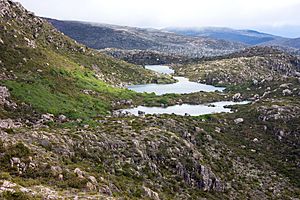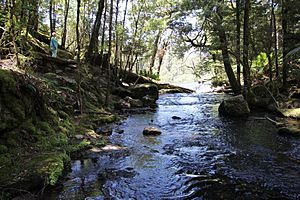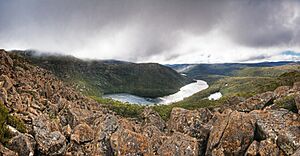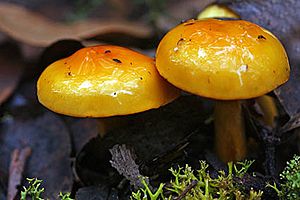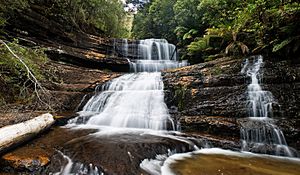Mount Field National Park facts for kids
Quick facts for kids Mount Field National ParkTasmania |
|
|---|---|
|
IUCN Category II (National Park)
|
|
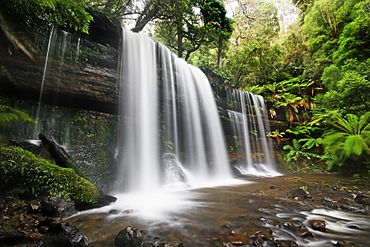
Russell Falls
|
|
| Nearest town or city | Maydena |
| Established | 1916 |
| Area | 162.65 km2 (62.8 sq mi) |
| Managing authorities | Tasmania Parks and Wildlife Service |
| Website | Mount Field National Park |
| See also | Protected areas of Tasmania |
Mount Field National Park is a beautiful national park in Tasmania, Australia. It's about 64 kilometers (40 miles) northwest of Hobart. This park is famous for its amazing landscapes. You can find everything from tall eucalyptus trees in cool rainforests to open, grassy alpine areas. The highest point in the park is Mount Field West, which is 1,434 meters (4,705 feet) tall.
Contents
History of Mount Field National Park
Mount Field National Park was created in 1916. This makes it one of Tasmania's oldest national parks, along with Freycinet National Park.
The area around Russell Falls has been protected since 1885 because of its natural beauty. It was Tasmania's first nature reserve. A sad part of the park's history is that the last known wild thylacine (Tasmanian tiger) was caught here in 1933. The park was officially named Mount Field National Park in 1947.
Why is it Called Mount Field?
Mount Field National Park is named after Judge Barron Field. He was a judge who visited Tasmania in 1819 and 1821.
How Glaciers Shaped the Land
Long ago, during the Ice Age (called the Pleistocene period), a huge snowfield covered the top of Mount Field. This snowfield fed glaciers that slowly moved through the valleys.
One large glacier was 12 kilometers (7.5 miles) long. It carved out the wide river valley and the steep walls around Lake Seal. Many small lakes, called tarns, like Twisted Tarn and Twilight Tarn, were also formed by these moving glaciers. These glaciers scraped and shaped the land, creating the beautiful features we see today.
Amazing Animals of the Park
Mount Field National Park is home to many native Tasmanian animals. If you visit, you might spot:
- Wombats
- Platypuses
- Eastern barred bandicoots
- Echidnas
- The famous Tasmanian devil
The Hidden World of Fungi
The park also has a huge variety of fungi. Fungi are super important for the environment, even though they are often overlooked. They play a big role in keeping the park's ecosystems healthy.
Most fungi are helpful. For example, saprobic fungi break down fallen leaves and branches. This process returns important nutrients to the soil, which helps other plants grow. Many plants in Mount Field National Park also have a special partnership with fungi called mycorrhiza. This helps both the plant and the fungus get nutrients.
Scientists and nature lovers have already found 289 different types of fungi in the park. You can even see the wood stained blue-green by a fungus called the Green Elfcup (Chlorociboria aeruginascens group). Another common fungus is the Slimy Yellow Cortinar (Cortinarius sinapicolor). It's bright yellow and often found near eucalyptus trees.
Where to Stay and What's There
At the entrance to the park, you can find camping spots for tents and caravans. There are also cabins near Lake Dobson, deeper inside the park. Some private clubs have huts, and there's a ski lodge that offers limited places to stay during the skiing season.
The Visitor Centre is near the park entrance. It has a cafe, a gift shop, and a gallery. You can also find public toilets there. Outside the Visitor Centre, there are picnic areas, barbecue facilities, and a playground.
Fun Activities to Do
Mount Field National Park offers many exciting activities, especially walking and skiing!
Walks from the Visitor Centre
These walks are easy and start near the main entrance:
- Russell Falls: This is an easy 20-minute walk on paved paths and boardwalks.
- Horseshoe Falls: This walk takes about 30 minutes.
- The Lady Barron Falls circuit: This longer walk takes about two hours. It includes Russell Falls and Horseshoe Falls.
- Tall Trees Walk: An easy 30-minute walk through giant swamp gum trees.
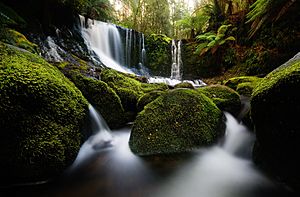
Walks from Lake Dobson Car Park
These walks are generally longer and more challenging:
- The Ski Lodge and Lake Seal lookout: About one hour return.
- Seagers Lookout: About two hours return.
- Mount Field East via Lake Nicholls: This takes about five hours return.
- Mount Field West: A longer hike, about eight hours return.
- Tarn Shelf, Lake Newdegate, Twilight Tarn and Lake Webster circuit: This takes about six hours return.
Skiing at Mount Field
Mount Field National Park has one of Tasmania's downhill skiing areas. There are three ski lifts available. Usually, there's enough snow for skiing from mid-July to mid-September.
See also
 In Spanish: Parque nacional del Monte Field para niños
In Spanish: Parque nacional del Monte Field para niños


